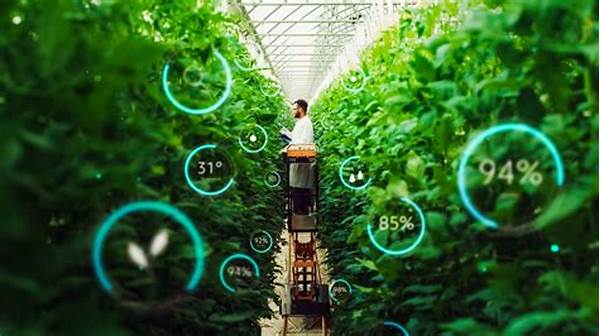The advancement of technology has significantly influenced the agricultural industry, heralding a new era where data-driven decisions are at the forefront of farming practices. As agricultural enterprises strive for higher efficiency, productivity, and sustainability, the integration of data analytics into their operational strategies has become indispensable. These data-driven decisions in agriculture offer the potential to optimize resources, enhance crop yields, and mitigate environmental impacts.
Read Now : Peer Review Process Innovations
The Importance of Data Analytics in Agriculture
In contemporary agriculture, data analytic tools enable farmers to transform raw data into actionable insights. Agricultural professionals utilize various data sources, including satellite imagery, sensor data, and weather forecasts, to make informed decisions. The implementation of data-driven decisions in agriculture allows for precise resource management, such as determining optimal planting times and identifying disease outbreaks. Consequently, these decisions not only enhance farm management but also contribute to economic and environmental sustainability.
Moreover, data-driven decisions in agriculture pave the way for predictive analytics, a transformative approach that assists in anticipating future trends and challenges. By leveraging big data, agricultural stakeholders can make strategic adjustments to farming practices before issues arise, ensuring resilience in the face of climate change and market fluctuations. The predictive capacity of data analytics ultimately strengthens the agricultural supply chain, bolstering food security and fostering innovation across the sector.
Key Advantages of Data-Driven Agriculture
1. Increased Crop Yields: Data-driven decisions in agriculture facilitate the adoption of precision farming techniques that optimize field variability and enhance productivity.
2. Resource Optimization: The use of data analytics aids in efficient water management and fertilizer application, reducing costs and environmental impact.
3. Risk Mitigation: By analyzing weather patterns and pest outbreaks, farmers can proactively mitigate risks associated with climate variability and biological threats.
4. Market Adaptability: Data-driven insights empower farmers to align production practices with consumer preferences and market demands.
5. Sustainability Initiatives: Data-driven decisions in agriculture support sustainable practices by promoting environmentally friendly techniques and reducing resource wastage.
Technological Tools Supporting Data-Driven Decisions
The proliferation of technological tools enables the seamless implementation of data-driven decisions in agriculture. Innovations such as Internet of Things (IoT) devices have revolutionized farm management by collecting real-time data on soil conditions, crop health, and machinery efficiency. This wealth of information provides farmers with a comprehensive overview of their operations, informing strategic planning and interventions.
Furthermore, Geographic Information Systems (GIS) and remote sensing technologies offer spatial data that enhances precision agriculture. These technologies allow farmers to visualize field variability and implement site-specific management, thereby maximizing yield potential. Coupled with machine learning algorithms, these tools enable the analysis of historical and real-time data, fostering predictive maintenance and decision-making processes.
Challenges in Implementing Data-Driven Agriculture
1. Data Complexity: The diverse and vast amounts of data generated can be challenging to analyze and interpret.
2. Infrastructure Limitations: In some regions, poor connectivity and inadequate technological infrastructure hinder data collection and usage.
3. Knowledge Gap: There is a need for training and education to enable farmers to leverage data analytics effectively.
4. Cost Concerns: The initial investment in technology and data analytics tools can be prohibitive for small-scale farmers.
Read Now : Climate Change Adaptation Frameworks
5. Data Privacy: Ensuring the security and privacy of data remains a critical issue in the agricultural sector.
6. Adoption Resistance: Some farmers may resist adopting new technologies due to traditional practices and skepticism.
7. Regulatory Barriers: Navigating the regulatory landscape can present challenges in terms of data sharing and compliance.
8. Customization Needs: Data solutions must be tailored to the specific needs and conditions of individual farms.
9. Interoperability Issues: Compatibility between various technological systems can be a hurdle to seamless integration.
10. Environmental Variability: Fluctuations in environmental conditions add complexity to data analysis.
The Future of Data-Driven Agriculture
The future of agriculture lies in the seamless integration of data-driven decision-making processes. As technological advancements continue to evolve, the agricultural industry must adapt to remain relevant and competitive. The adoption of data-driven decisions in agriculture heralds a shift from traditional farming to smart agriculture, where insights derived from data guide every aspect of farming operations.
As the global population continues to grow, the demand for food production intensifies. Data-driven agriculture provides the tools necessary to meet these challenges by ensuring optimal resource allocation, enhancing productivity, and reducing environmental impacts. The capacity to predict and adapt to climatic changes, market trends, and pest management challenges positions data-driven agriculture as a crucial factor in achieving global food security.
Conclusion: Embracing Data-Driven Decisions
In conclusion, the adoption of data-driven decisions in agriculture is no longer a choice but a necessity for modern farming. The myriad benefits, including improved efficiency, enhanced sustainability, and strategic foresight, underscore the value of integrating data analytics into agricultural practices. By embracing this innovative approach, the agricultural sector can unlock its full potential, paving the way for a future that meets the needs of a burgeoning global population.
The success of data-driven agriculture, however, hinges on overcoming implementation challenges. Investments in infrastructure, education, and policy development are paramount to facilitate the widespread adoption of data analytics across diverse farming communities. Ultimately, fostering collaboration among technology providers, policymakers, and farmers will be instrumental in realizing the transformative potential of data-driven decisions in agriculture, shaping a sustainable and prosperous agricultural future for all.
